Agata Storer Connects Time, Place, and Memory
Photographer Agata Storer is interested in how we remember. She’s long been obsessed with documentation, something she attributes, in part, to a life spent moving around. Lately, Storer, who is from Poland and is a regular contributor to the Independent, says she’s been reflecting on when she first arrived on the Cape three years ago.
“When you’re new in a place, you see more,” she says.
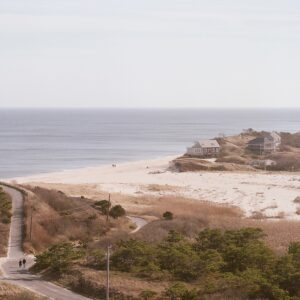
In her latest project, Storer has revisited many of her initial images of the Cape, taking new photos to create a series that connects time, place, and memory. The exhibition, titled “After Before,” opens at 3 West Main (3 West Main St., Wellfleet) on Saturday, Aug. 3, with a reception from 6 to 9 p.m. It is on view until Aug. 14.
The new exhibition space, which is attached to the Sickday surf shop and Gelato Joy Cafe in Wellfleet, is managed by Kai Potter, who also contributes to the Independent, and Eliana Pasternak on behalf of the owners, Angie and Olaf Valli. It aims to increase exhibition accessibility for artists, Potter wrote in an email, adding that he hopes to “create a vibrant little cultural corner in this artistically rich community.”
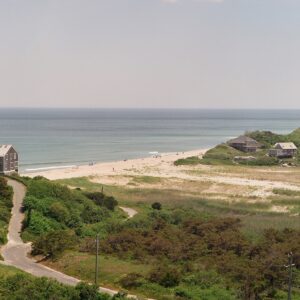
Some of Storer’s photos are clearly paired, like two images of Ballston Beach. Taken several years and seasons apart, the photographs show vibrant summertime greenery juxtaposed with muted winter browns and the changes in the landscape caused by erosion.
In other photographs, the temporal relationship is more subtle. In what Storer says is her favorite image of her son, Noah, taken during a haircut, shorn clippings rest on his neck and shoulders. Coupled with a similar shot from three years earlier, Storer says it offers insight into her son’s growth: he was “very brave” this time around, while in the earlier haircut, “He cried.”
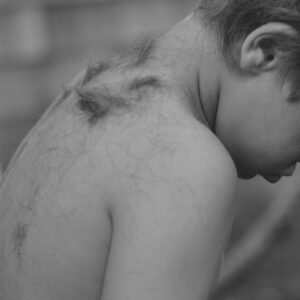
Many of the images have no visual counterparts. Storer likes the idea of having more “befores” than “afters,” so she can revisit the “befores” later on. But even the meaning of the most recent shots evolves with time.
“Every after becomes before,” she says. “I can’t influence people with my emotions, but I can direct them to their own memories.” —Jacob Smollen
Remembering an Artist and Friend
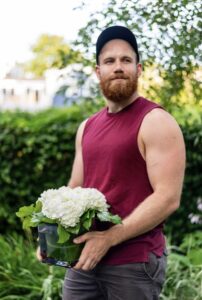
In the four years that he called Provincetown home, artist and software engineer Benjamin “Benji” Weinryb Grohsgal, who died of brain cancer last month at age 37, became a familiar and much-loved figure in the creative community and town at large. At his memorial service at the Provincetown Brewing Co. on July 23, artist and gallery owner Gaston Lacombe announced the establishment of a fund supporting local artists in Grohsgal’s honor.
“Before passing away, Benji left me with two things,” says Lacombe, who had previously organized two solo shows of Grohsgal’s work at his gallery. “He left me his last collection of prints, and he left me with the task to donate all the proceeds from the sale of these works to a charity of my choice. Considering the impact Benji has had on Provincetown, I decided I wanted these funds to stay in our community.”
With the approval and assistance of Grohsgal’s family, Lacombe brought the idea of a memorial fund to Provincetown Commons Executive Director Lesley Marchessault and Director of Operations David LaFrance. They established the BWG (Benji) Fund at The Commons, where Grohsgal was a resident artist. According to Lacombe, the fund will “support local artists and creatives and assist them in maintaining a sustainable art practice.”

A one-night exhibition and fundraising sale at Studio Lacombe (237 Commercial St., Provincetown) on Friday, Aug. 2 will feature a selection of Grohsgal’s prints for sale. Proceeds will be donated to the newly established fund, and donations can also be made on the Provincetown Commons website.
“Benji left a very distinctive mark on this community,” says Lacombe, “and Provincetown notably provided Benji with a supportive and encouraging environment in which to express himself artistically. I hope this fund can keep Benji’s memory and legacy alive.” See provincetowncommons.org/contribute/benji and studiolacombe.com for more information. —John D’Addario
Frederick Brosen Paints Provincetown in Detail
Frederick Brosen gets up at dawn to find scenes for his paintings. When he finds one, he sketches, photographs, and sketches it again. Beginning with light washes of color, he slowly builds his images in rich, bold tones.
The William-Scott Gallery will show Brosen’s richly detailed watercolor paintings of Provincetown in an exhibition opening Friday, Aug. 2. Brosen began the series in 2019 during his first visit to the Outer Cape in almost 20 years.
Brosen’s precise attention to detail is evident in Dayglow, Provincetown Bay. The shadow of the boat looms in the water behind it. We know the tide is low because the buoy is practically resting on the sand. The Pilgrim Monument looks stubby in the distance, so Brosen must be far out in the West End. Ropes hang underneath the small red boat’s wrapped sail.
There’s a similar level of detail in Dawn Light, Provincetown, which Brosen painted from the yard next to the Grozier-Cabral House at 160 Commercial St. The sky is waking up, and the town is still asleep. The golden early morning sunlight hits the cupola of the house, matching the gold forsythia below. Rectangular windows create smaller abstracted views within the scene, while a birdhouse in the center anchors the whole composition.

Canteen, Provincetown depicts the winding path to the harbor behind the Canteen restaurant on Commercial Street. Three red flags wave in the light breeze, shadows of tree branches cover the sand, and white yachts pattern the waterfront. Blue and red striped buoys cap both sides of a bench. Fittingly, the painting resembles an organized and colorful lunchbox.
Brosen looks straight down Good Templar Place in the West End toward the water in Flyer’s Boat Rental. Puddles pool after a rain, and yellow flowers grow between cracks and gaps in the concrete. The worn sides of a boathouse to the right are marked by time, as are shingles on the shack. Brosen’s careful attention to detail gives the shingles — and the scene as a whole — an almost photographic presence and weight.

Brosen, who lives in New York City, received his B.A. from New York’s City College and studied at the Art Students League in the mid-1970s. He received his M.F.A. from Pratt Institute in 1979. His work has been acquired by the Metropolitan Museum of Art and the New-York Historical Society.
The exhibition is on view until Aug. 14. See williamscottgallery.com for information. —Pat Kearns
Heathers the Musical Explores the Dark Side of High School
Four years after it was originally scheduled, the regional premiere of Heathers the Musical at the Academy of Performing Arts in Orleans opens on Friday, Aug. 1. Despite the pandemic-related delay, director Karen Hepinstall says she was determined to make the stage version of the 1989 movie satire of high-school life happen. (Two of the actors originally cast in the 2020 production will appear in lead roles.) Hepinstall also hopes the edgy black comedy — which deals with teen suicide, sexual assault, and bullying — will attract new audience members, particularly younger ones, to the theater.
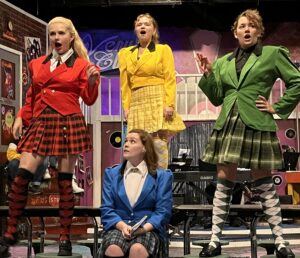
While some previous productions have chosen a campy, goofy tone for the show, Hepinstall says she’s going for a darker one. “I want the audience that might be thinking, ‘Oh my gosh, I love [the movie] Heathers. This is going to be so much fun!’ to leave thinking, ‘That was a lot,’ ” she says. “I want people to have a good time, but I want them to be moved when they watch it.” A chemistry and forensic science teacher at Nauset Regional High School, Hepinstall advises Nauset’s feminist club.
The story centers on high school student Veronica (Virginia Ohlson) and new guy JD (Oli Kuehne), who team up for an unorthodox revenge against a clique of popular girls known as “the Heathers” and a pair of sexually violent members of the school football team. “The Heathers are bullies — they’re mean and gross,” says Hepinstall. “And the two football boys are mean and gross. If you make it too campy, people laugh at them and think it’s funny. I’ve told my actors, ‘I really want the audience to not like you for what you do.’ ”
The movie was released in 1989. Hepinstall says that the 2014 musical “has an important message because all these things still happen. It’s certainly still really relevant.”
Heathers the Musical runs through Sunday, Aug. 18 at 120 Main St., Orleans. Tickets are $25-$35 at academyplayhouse.org. —Kathi Scrizzi Driscoll
Kurt Reynolds Mixes Media and Memory
The work of artist Kurt Reynolds, currently on view at Rice Polak Gallery in Provincetown, is about political violence, climate change, and war. “My work is a way of looking back at some of the silences I grew up around,” he says. “People never talked at the kitchen table.”

Reynolds, who moved to Provincetown in 2013 and works out of his basement studio off Conwell Street, uses a wide range of materials in his mixed-media assemblages. In Mapping the Shipwrecks, the dark sea is made from a piece of blue velvet from an old violin case. A piece of bone suspended inside the frame hovers over the water, and the wood frame itself gives the work its depth and dimension.
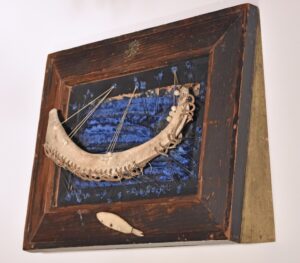
January 6 Insurrection, Christian Nationalism is a timely look at our current political atmosphere. A conspiratorial clown smiles after kicking over an innocent chair. He holds a pole with a torn hand at the top after robbing the flesh from the Statue of Liberty. A Nazi badge is embroidered into the back wall of the assemblage, positioned underneath a torn star.
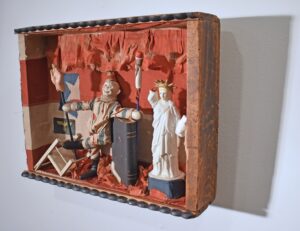
Several of Reynolds’s works have a similar narrative element. “Sometimes I’ll have a story in my head, and I’ll look for materials to flesh that out,” he says. His assemblage Otto Weidt’s Workshop for the Blind, Berlin, 1936-1945 tells the real-life story of a brush-making and broom-binding workshop that employed mostly deaf and blind Jewish workers in Nazi Germany.
“[Weidt] kept people alive as long as he could,” says Reynolds. “I’ve done a couple pieces about the Holocaust because of the rise of anti-Semitism in the United States.” Reynolds went to Berlin and saw the machines Weidt used to make the brushes. His assemblage includes more than 20 vintage natural hair bristle brushes with red paint stippled on them, and a sharp railroad track runs down its left side.
In A Hard Rain’s Gonna Fall, Reynolds inserted a doll and a figurine of a dead pony into an old Morse code machine from World War II. A vintage American flag is tucked into the back of the machine. Reynolds explains that the little doll is supposed to be Donald Trump, with his finger on the button of the machine. “I met one man who was wounded in love/ I met another man who was wounded in hatred/ a hard rain’s a-gonna fall,” sings Reynolds. The words, of course, are Bob Dylan’s.
For Reynolds, art is as much about the process as it is about the final result. “Things change,” he says. “I do a lot of editing before I come out with the final piece. I’m interested in composition and materials. Sometimes I’ll have eight objects that are one or two too many.”
There will be an opening reception for Reynolds’s show on Friday, Aug. 2, from 6 to 8 p.m. The show is on view until Aug. 14. See ricepolakgallery.com for information. —Pat Kearns
Steel Pulse Plays for Unification
British roots-reggae band Steel Pulse is coming to the Outer Cape this weekend with a message: “A manipulation of our minds has been influenced by a New World Order currently dominating humankind.” Humanity, their website states clearly and insistently, is becoming increasingly divided. Unity is their goal; music is their vehicle to get us there. The group will play at Payomet Performing Arts Center on Saturday, Aug. 3 at 8 p.m.

Their 12th studio album, Mass Manipulation, was released in 2019, more than four decades after the band’s 1975 founding. Its songs range in tone from uplifting to eerie, groovy to uneasy. In some moments, a seductive bass line melds with the tap and hiss of percussion, while in others the strident call of a horn jolts the listener and commands her to pay attention.
The slower tempos and head-bobbing offbeats characteristic of reggae music are present in the band’s distinctive sound. But the music of Steel Pulse is more than just mellow listening, as evidenced by song titles like “Black and White Oppressors,” “World Gone Mad,” and “Human Trafficking.” Other tracks — like “Rize,” “Thank the Rebels,” and “Nations of the World” — carry a more inspiring message.
Steel Pulse will take the stage in North Truro during a particularly divisive moment in our history. Music, the band seems to be saying, is a potent tool to address divisions.
Tickets are $40 to $60 at tickets.payomet.org. —Dorothea Samaha



